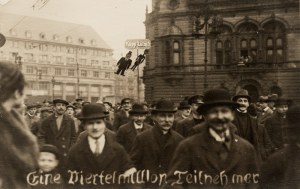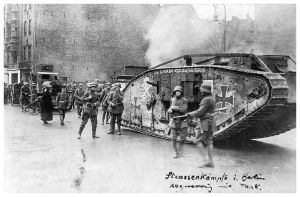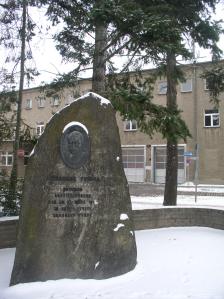 During the Weimar Republic (1918-1933) there were various attempts to throw over the young democracy. An important attempt was the Kapp-Putsch in 1920. In this, para-militaric Freikorps (‘free batallions’) took control on the 13th of March. The legal government fled from Berlin to Stutgart. So, the overthrow succeeded for four days. However, it was knocked down again before it stabilised. Thanks to a mass strike that was initiated by the social democratic government, the Kapp-Putsch was history by the 17th of March. What happened more and how is this act remembered?
During the Weimar Republic (1918-1933) there were various attempts to throw over the young democracy. An important attempt was the Kapp-Putsch in 1920. In this, para-militaric Freikorps (‘free batallions’) took control on the 13th of March. The legal government fled from Berlin to Stutgart. So, the overthrow succeeded for four days. However, it was knocked down again before it stabilised. Thanks to a mass strike that was initiated by the social democratic government, the Kapp-Putsch was history by the 17th of March. What happened more and how is this act remembered?
The first years of the Weimar Republic were extremely violent. One can even say that the First World War didn’t end for many of its German soldiers. Of huge importance in this violence were the Freikorps (Free Corps), which were basically para-military armies which could be used for political purposes. Within Weimar Germany, 250.000 men were employed in these organisations. Most of these Freikorps were formed by veterans from WWI which generally had right-wing sympathies. Fed by the stab-in-the-back myth, they felt that the Weimar Republic was an illegal overthrow of the monarchy. Nevertheless, the SPD (social democratic party) made use of these Freikorps in the battle against communist and socialist uprises, which made the para-military soldiers aware of their powerful position.
Various officers who would have lost their position decided to throw over the young democracy. Among the officers were general Walther von Lüttwitz and Hermann Ehrhardt. In the night from the 12th to the 13th of March 1920, Ehrhardt with its 5000 soldiers invaded Berlin. They took over the power without any resistance in the ministerial quarter around the Wilhelmstraße. The head of the Reichswehr (German army) Hans von Seeckt did not make an effort to knock down the uprise. Von Seeckt’s answer on the command to knock down the strike became (in)famous: “Reichswehr schießt nicht auf Reichswehr.” Pretty much meaning: “The army doesn’t shoot at the army.” In the meanwhile, they installed a new government. The rightist civil servant Wolfgang Kapp was inaugurated as the Reichskansler (Chancellor).
Ofcourse, several powerfull elites didn’t acknowledge Kapp’s new government. The social democratic officials launched a labour strike on the 13th or March. Various social democratic and communist labour unions striked, as did the Deutscher Beamtenbund (German Civil Service Federation). With its 12 million strikers, it was the biggest strike in German history. The U-Bahn and S-Bahn striked, the production in fabrics were put on a hold and all the houses in Berlin were without gas, water and light. Kapp’s government did not have any plan yet for knocking down the strike. Instead, Kapp fled to Sweden at the 17th of March. Ehrhardt still commanded his soldiers. The order was finally restored by the 21st of March. The Weimar Republic seemed to be save.
The restoration of the coupe was bloody, though it were not Ehrhardt and his soldiers who had to fear for their lifes. Socialists and communists kept on striking for a revolution – especially in the Ruhrgebiet, but also in Berlin. In Köpenick, it came to Köpenicker Blutsonntag (Köpenick’s bloody Sunday). Here, Alexander Futran lead the well organised resistance against Ehrhardt’s troups. Although he had the intention to give the power back to the legal government, he and four strikers were accused by the Reichswehr for the possesion of illegal weapons. They were executed after a military court the same day, March 21st. That Futran was a left-wing intellectual from jewish descent contributed to the lack of any judicial defence. After the executions, their left-wing comrades fought against the Reichswehr soldiers and their supporters. Another 14 strikers died, as well as one soldier and three students who fought on the Weimar Republic’s side.
The initiators of the Kapp-Putsch were hardly brought to court. Many of the coupe’s organisators moved to Bavaria, where Ehrhardt founded the Organisation Consul. This organisation killed various democratic key-figures, of which the assasination of Walter Rathenau became the most (in)famous. In this violent climate, Hitler found his contacts to organise a coupe in November 1923. This Bierkellerputsch failed at first, but became a memorial day ten years later. That’s when Hitler and the extreme-right threw over Weimar’s democracy after all.
Directly after the Kapp-Putsch failed – a sculpture was build in Weimar. The monument opened at May 1st 1922. The monument was behated by the nazi’s, also for its modern design which was made by Martin Gropius. The nazi’s demolished the monument in 1936 – but was restored after the Second World War. In the meanwhile, the nazi’s even build a memorial in Essen; for the soldiers who tried to overthrow the regime!
In Berlin, the Köpenicker Blutsonntag is remembered at Friedhof Adlershof. The ashes or Alexander Futran were placed at the Sozialistenfriedhof. The Köpenicker Blutsonntag was remembered yearly till 1933, when nazi’s destroyed the memorial stone. In 1947, a square in East-Berlin’s Köpenick changed its name to Futranplatz. At the station of Berlin-Grünau, a memorial stone was build to remember the men who fell when the Kapp-Putsch was knocked down. Other memorial stones are erected in the previous western sector, at Schöneberg’s Kaiser-Wilhelm-Platz. At this square, five strikers were shot on March 15th. When the coupe failed, the mass of people wanted to revenge these victims and went to the square again. One soldier surrender but was killed, the rest fought their way out of the building – shooting another six civilians. Three of them are given a grave at the Friedhof Eythstraße.
By the looks of it, the Kapp-Putsch brought more losers than winners. The official government revealed how weak its democracy was. It went in exile without being defended for even a second – and it was saved by a general strike. The organisors of the Kapp-Putsch and their soldiers were losers because they failed and were hated. The strikers might have been the winners of this episode – although the strike ended in confusion and bitterness when the power was restored. Remarkably, there is no place in Berlin that remembers the Kapp-Putsch. Nor for the strike which saved the democracy… In Berlin, this history is only remembered by small initiatives from different times. Probably, a history with too many losers will lose its place in history itself.





Pingback: Marinus van der Lubbe (1909-1934) and his Reichstag Fire. | Historical tales about the capital of the 20th century
Pingback: Overview | Historical tales about the capital of the 20th century